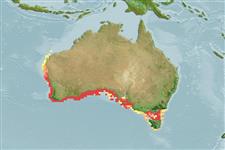>
Perciformes/Scorpaenoidei (Scorpionfishes) >
Pataecidae (Australian prowfishes)
Etymology: Neopataecus: Greek, neos = new + Pataeco, adwarf like Phoenician god. Refers to the likeness of this species to the image of gods on the bows of ancient sailing vessels (Ref. 45335).
Eponymy: Frederick George Waterhouse (1815–1898) was an English naturalist who made important contributions to the study of Australian fauna and flora. [...] (Ref. 128868), visit book page.
More on author: Castelnau.
Environment: milieu / climate zone / depth range / distribution range
पारिस्थितिकी
समुद्री ड़िमरसल. Temperate
Eastern Indian Ocean: endemic to Australia (Ref. 7300): South Australia.
आकार / वज़न / Age
Maturity: Lm ? range ? - ? cm
Max length : 22.0 cm TL पुल्लिंग / अलिंग; (Ref. )
Found on the continental shelf. Benthic (Ref. 75154). Max length from Fishes of Australia website: http://fishesofaustralia.net.au/home/species/2173.
Life cycle and mating behavior
परिपक्व अवधि | पुनरुत्पत्ति | मछलीऔ का अंडे देना | अंडे | Fecundity | लार्वा
Paxton, J.R., D.F. Hoese, G.R. Allen and J.E. Hanley, 1989. Pisces. Petromyzontidae to Carangidae. Zoological Catalogue of Australia, Vol. 7. Australian Government Publishing Service, Canberra, 665 p. (Ref. 7300)
IUCN Red List Status (Ref. 130435: Version 2024-1)
Threat to humans
Harmless
Human uses
साधन
Special reports
Download XML
इंटरनेट स्रोत
Estimates based on models
Preferred temperature (Ref.
123201): 15.1 - 20.6, mean 16.9 °C (based on 90 cells).
Phylogenetic diversity index (Ref.
82804): PD
50 = 1.1250 [Uniqueness, from 0.5 = low to 2.0 = high].
Bayesian length-weight: a=0.00389 (0.00180 - 0.00842), b=3.12 (2.94 - 3.30), in cm total length, based on all LWR estimates for this body shape (Ref.
93245).
Trophic level (Ref.
69278): 3.6 ±0.4 se; based on size and trophs of closest relatives
Fishing Vulnerability (Ref.
59153): Low vulnerability (12 of 100).
